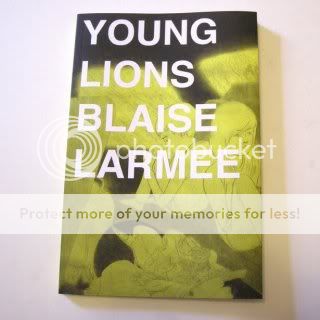Young Lions
Blaise Larmee, writer/artist
self-published, March 2010
96 pages
$10
Now here’s an interesting combination: A fairly straightforward “aimless young smart people” graphic novella in the vein of Adrian Tomine or Ghost World-era Dan Clowes, drawn in the wispy, dreamlike style of C.F. Larmee’s take on the CF “tradition”* foregrounds its frequent warm beauty rather than its fetishistic cold transgression. It pushes back the Henry Darger and pulls forward the Nell Brinkley, if you will.
This has a dual effect within the narrative (“story” isn’t quite right), which is about three young “conceputal artists” whose routine is shaken up by the unexpected intrusion of a beautiful young woman whose drunken disruption of one of their performances leads to their most successful gig yet, and a subsequent road trip to determine whether she’s worthy of official inclusion in the group. First, in the hands of Larmee’s delicate pencil line, these people are gorgeous–skinny, babyfaced androgynes constantly hitting effortlessly languid, painfully beautiful poses. If the characters in Young Lions were real, you might not want to talk to them, but you’d sure wanna stare at them, or, you know, dash your heart to pieces on the rocks of their indifference, tossing underappreciated mix CDs in their direction every now and then.
The second effect the beauty of the art, and by extension the characters, has on the narrative is making it immersive and appealing. A lot more so, in fact, than it might otherwise have a right to be. Cody and Alice seem completely oblivious to how easy they have it as (apparently) wealthy, (definitely) gorgeous, (avowedly) artsy young Americans; Wilson is less attractive but makes up for it by sheer force of obnoxious intellectual domineering and is the type you know will always be able to find a scene he can dominate; Holly is a bit harder to get a handle on, but she clearly enjoys the attention inherent in her exploitation by the trio and is thus difficult to sympathize with even as the others condescend to her naivete and poverty. A less charitable documentarian of this particular demimonde might simply stick “Bohemian Like You” by the Dandy Warhols on loop and be done with it. In the hands of a less visually charitable cartoonist–Clowes, say, or even Tomine!–this would read as a pretty merciless satire. Given Larmee’s deeply unfortunate internet persona (the fact that it’s a put-on doesn’t make it any less of a head–scratching headache inducer), you might even say merciless satire is what both characters and creator deserve.
But when I said Larmee is dragging the beauty of this art style forward, I meant that literally: As opposed to CF’s side-scrolling distance, we’re in constant close-up close quarters with this quartet. Their reclining bodies occupy entire panels, their upturned, closed-eye’d faces appear inches away from our own, the background details are all but nonexistent. It’s tough to stand in judgement of people you’re seeing primarily through the POV you’d get if you were about to make out with them, you know?
It’s that intimacy that makes Young Lions successful, that makes the whole greater than the sum of its parts. Yes, these are assholes. But who–especially among artists and arts-interested people of the sort who’d buy a Xeric-winning self-published graphic novel such as this one–hasn’t been an asshole? Who hasn’t been friends with assholes, worked with assholes, been impressed by the creative output of assholes, been disappointed with the creative output of assholes, fallen in and out of love with assholes? Larmee may doom them to an open, down ending, but as Kevin Smith once said, that’s exactly what life is. Beyond that it’s not our place to judge.
* the emergence of which is fascinating to me, by the way, a second generation of the Providence artcomics aesthetic following Fort Thunder and Paper Rad, which are themselves obviously quite distinct but still noise-dominated while I think CF is quiet-dominated, but anyway
Tags: comics, comics reviews, Comics Time, reviews


This might be, in my opinion, the most dead-on review of this piece of work that I have read.
The artwork is stunningly elegant and lyrical.
But Larmee seems to be stuck in that same rut as Tomine before him in that he seems to create the kind of characters that he wants to cultivate in his readership. In this case, that would apparently be blowhard trust-fund art-babies. Hopefully he grows out of this affectation.